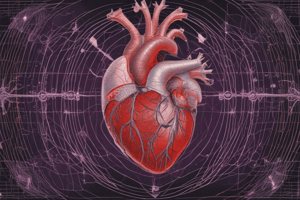Podcast
Questions and Answers
What is the main function of the systemic circulation?
What is the main function of the systemic circulation?
- Transport deoxygenated blood to the lungs
- Force blood into the arteries
- Transport oxygen and nutrients to body tissues (correct)
- Relax and fill with blood
Which heart condition results in abnormal electrical signals causing uneven heartbeats?
Which heart condition results in abnormal electrical signals causing uneven heartbeats?
- Arrhythmia (correct)
- Heart failure
- Heart attack
- Coronary artery blockage
During which phase do the ventricles passively fill just before the next beat?
During which phase do the ventricles passively fill just before the next beat?
- Between Systole and Diastole
- Early Ventricular Diastole
- Ventricular Systole
- Late Ventricular Diastole (correct)
What is the primary implication of heart failure?
What is the primary implication of heart failure?
Which circulation transports deoxygenated blood to the lungs to get oxygen?
Which circulation transports deoxygenated blood to the lungs to get oxygen?
Which chamber of the heart has thicker muscular walls to pump blood through pulmonary circulation?
Which chamber of the heart has thicker muscular walls to pump blood through pulmonary circulation?
What is the function of the septum in the heart?
What is the function of the septum in the heart?
During which phase of the cardiac cycle do the atria contract, forcing blood into the ventricles?
During which phase of the cardiac cycle do the atria contract, forcing blood into the ventricles?
Which vessel receives oxygenated blood from the lungs and delivers it to the left atrium?
Which vessel receives oxygenated blood from the lungs and delivers it to the left atrium?
What is the main function of the right atrium in the heart?
What is the main function of the right atrium in the heart?
Study Notes
Heart Function and Circulation
- The main function of the systemic circulation is to transport oxygenated blood from the heart to the rest of the body.
- Atrial fibrillation is a heart condition that results in abnormal electrical signals causing uneven heartbeats.
Cardiac Cycle
- During the diastole phase, the ventricles passively fill just before the next beat.
- During the atrial contraction phase, the atria contract, forcing blood into the ventricles.
Heart Failure and Circulation
- The primary implication of heart failure is the inability of the heart to pump enough blood to meet the body's needs.
- Pulmonary circulation transports deoxygenated blood to the lungs to get oxygen.
- The right ventricle has thicker muscular walls to pump blood through pulmonary circulation.
Heart Structure and Function
- The septum in the heart separates the left and right sides of the heart, allowing for the separation of oxygenated and deoxygenated blood.
- The right atrium receives deoxygenated blood from the body and sends it to the right ventricle.
- The pulmonary veins receive oxygenated blood from the lungs and deliver it to the left atrium.
Studying That Suits You
Use AI to generate personalized quizzes and flashcards to suit your learning preferences.
Description
Test your knowledge of the basic anatomy and physiology of the human heart, including the cardiac cycle, blood flow, and functions of major heart parts. This quiz includes labeling heart diagrams and describing the functions of five major parts of the heart.




